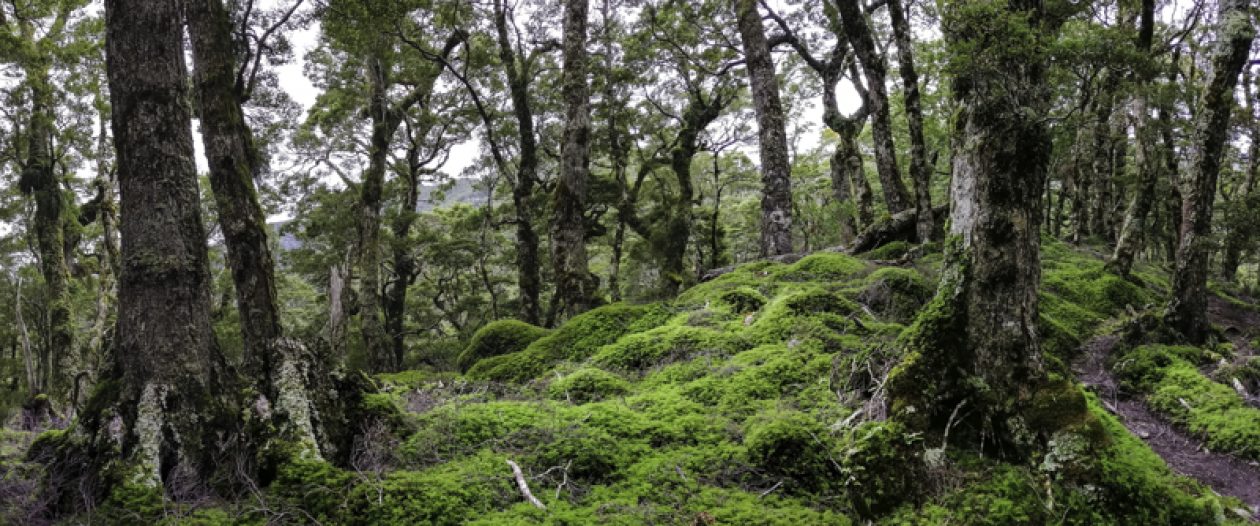I wanted to experience one of South East Asia’s classic train journeys – the last remaining conventional diesel engine trains before they are all electrified – The East Coast Railway Line (ECRL). Sometimes referred at the ‘Jungle Railway’. Built by indentured Tamil laborer between 1910 and 1931, the 530km track was built through difficult terrain, rivers, wet tropical weather and mountains. It was originally known as “Golden Blowpipe”. The builders followed the most convenient way – followed the lowest points – the river. The single track passed through plantations, village houses on stilts surrounded by tall coconut palms and mango trees; crossed a network of muddy streams and rivers over historic bridges and tunnels; and tracts of lush jungle. There is only one service on this single track, east and south bound, between Johor Bahru (near Singapore) to Tumpat (near the Thailand border). This is also the only service with sleeper amenity (ERT26/ERT27) offered by KTM. To fully appreciate this service, I did this journey in parts. Partly, to enjoy the ride in daytime as well as seeing interesting places. More importantly, to see the jungle as it is diminishing at a alarming rate to Palm Oil cultivation. I want to re-live the nostalgic journey of its hey days.
My train journey on the East Coast Railway Line (ECRL) began in Gemas. However, I would do it in 3 legs. First from Gemas to Jerantut. Second from Kuala Lipis to Gua Musang. Finally, on the iconic long distance conventional diesel locomotive with sleeper carriages (day and night) facility from Gua Musang to Tumpat.
1st leg – Gemas to Jerantut
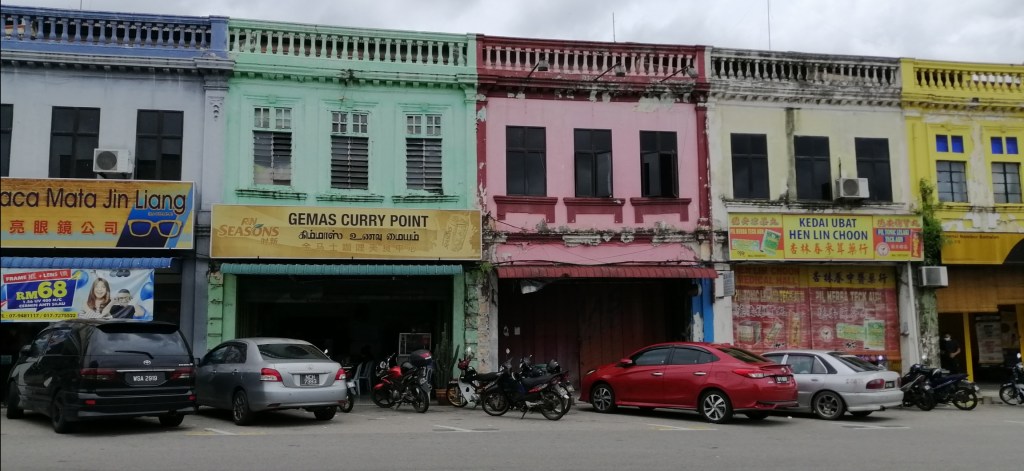
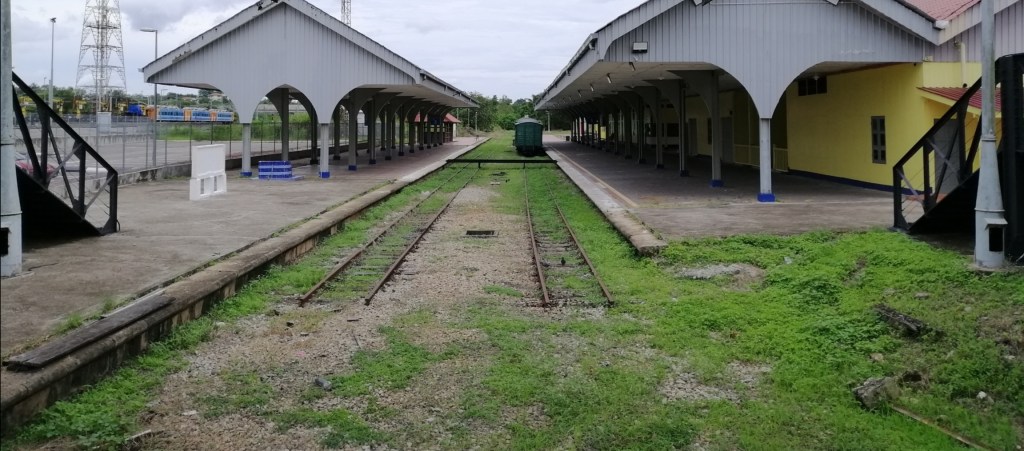

For my 1st leg, I returned to Gemas for an onward journey to Jerantut. The reason is to visit Taman Negara (National Park) located in Kuala Tahan. I boarded the DMU Shuttle 36 at 1535. To take the conventional diesel express train (ERT26), I needed to depart at 0118! This is the first time I had taken the East Coast Railway Line (ECRL). Besides that, this was my first visit to the National Park (Taman Negara). The DMU Shuttle is primarily providing transport service to interior smaller towns where road access is limited. Thus included plantations and villages. The cafeteria on this train today had no service. Gemas is also the junction where the East Coast and West Coast Railway Lines meet. As such, has a large depot for maintenance.
Departing Gemas, the coaches were almost empty. Only 3 passengers in my coach. Train speed was between 35-55kph through mix of rubber and large oil palm cultivation, and across small rustic townships. In the villages, under rambutan trees, kids chatted while lying in hammocks. Passed a couple of palm processing factories and labour quarters. Stands of rubber trees with tapping panels on the trunk and black collection cups line the part of the track. Horns were sounded occasionally as the track passed close of inhabited but rural areas. This ride truly gave an insight into rural life.
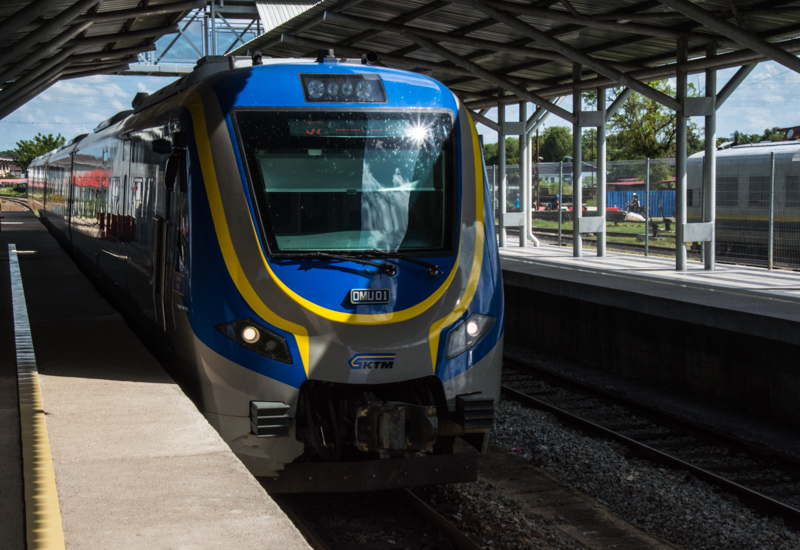
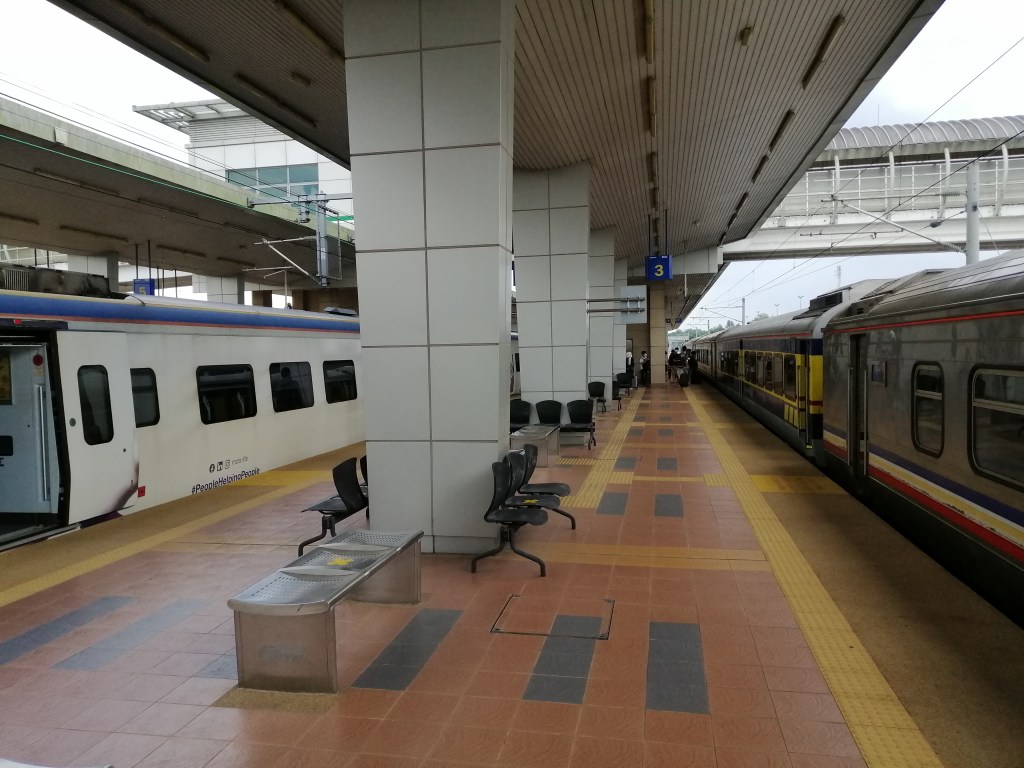

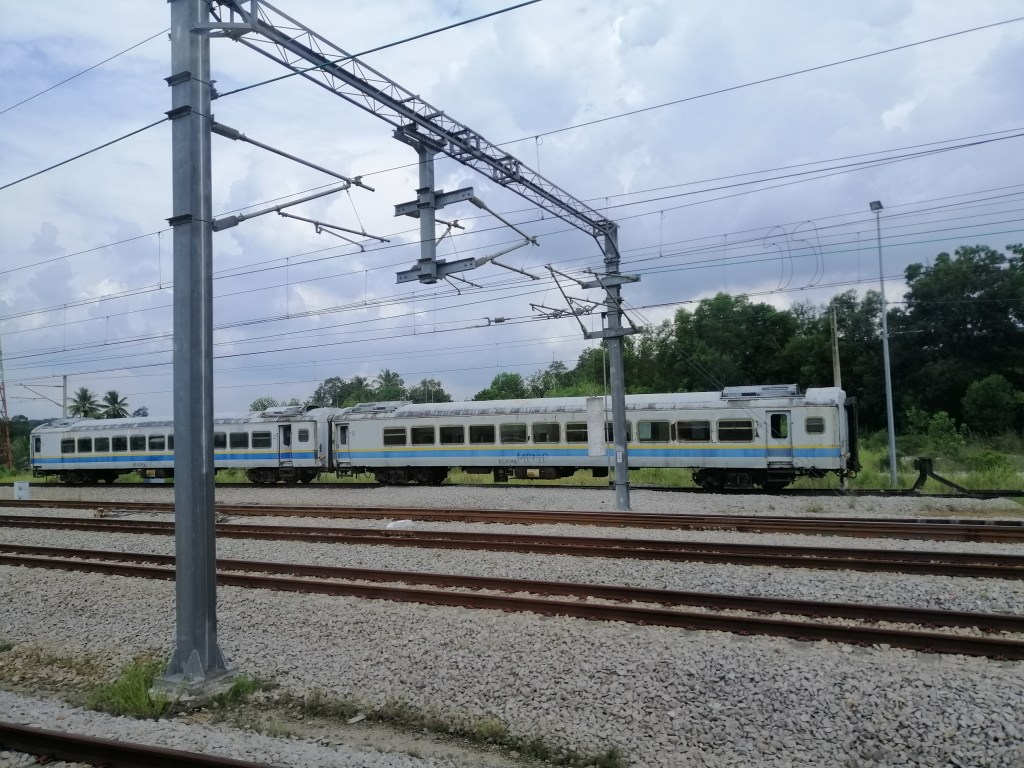

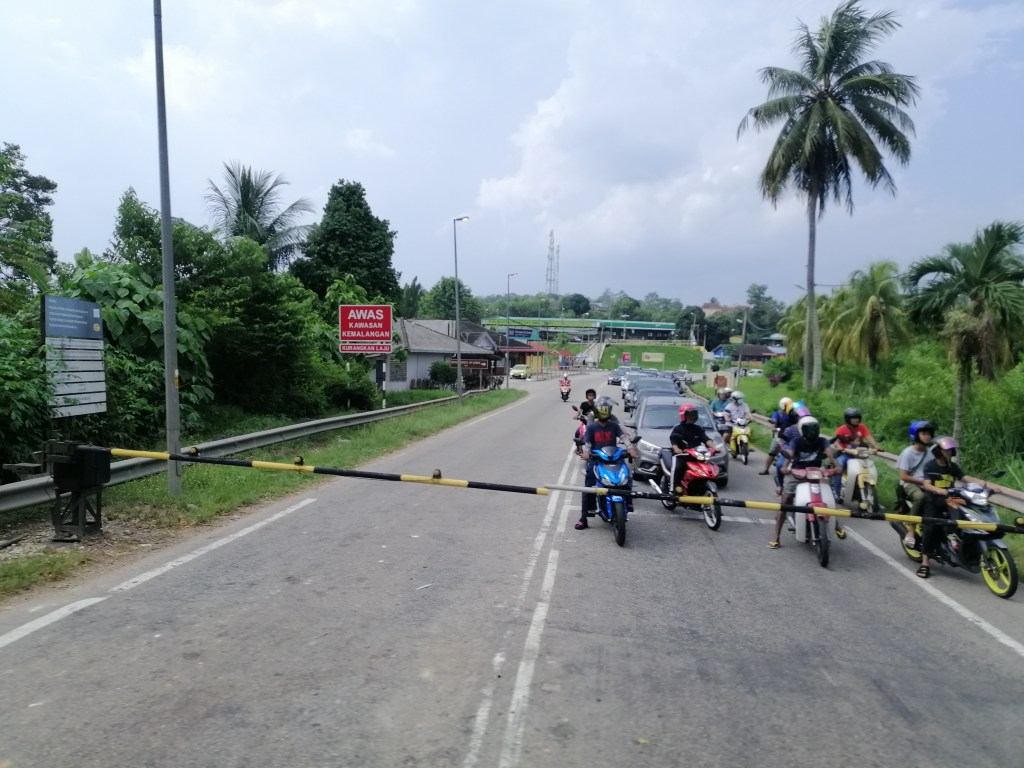
However, at next stop in Bahau Station, the crowds began to fill. Many were locals visiting friends and relatives during the Raya season. Malay women in head scarfs from Mentakab returned after holidaying in Bahau. The festivity mood spread around the coach. Stops were frequent, as its a peoples train. We passed market stalls and villages mosques. Train slowed down in places as cattle crossed the tracks. Several road crossings are passed with road traffic brought to a halt. Not long after, the track passed through large oil palm plantations and processing factories.
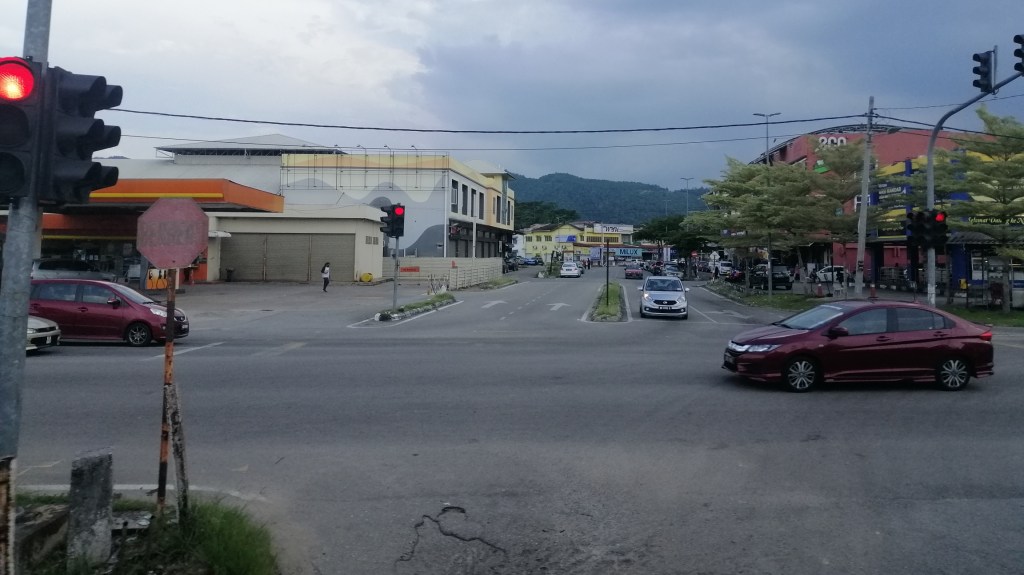

A brief stop at Kemayan Station and within minutes at Triang Station where, mostly Chinese passengers with shorts and t-shirts boarded the shuttle. Mentakab Station is a significant stop for those intending to travel to Kuantan (via the East Coast Expressway), the capital of Pahang, on the coast. It is also the exit point to Kuala Gadah Elephant Sanctuary (on the fringe of Krau Wildlife Reserve). To get there, take Highway 2 to Lanchang and then follow route 236 to the sanctuary.
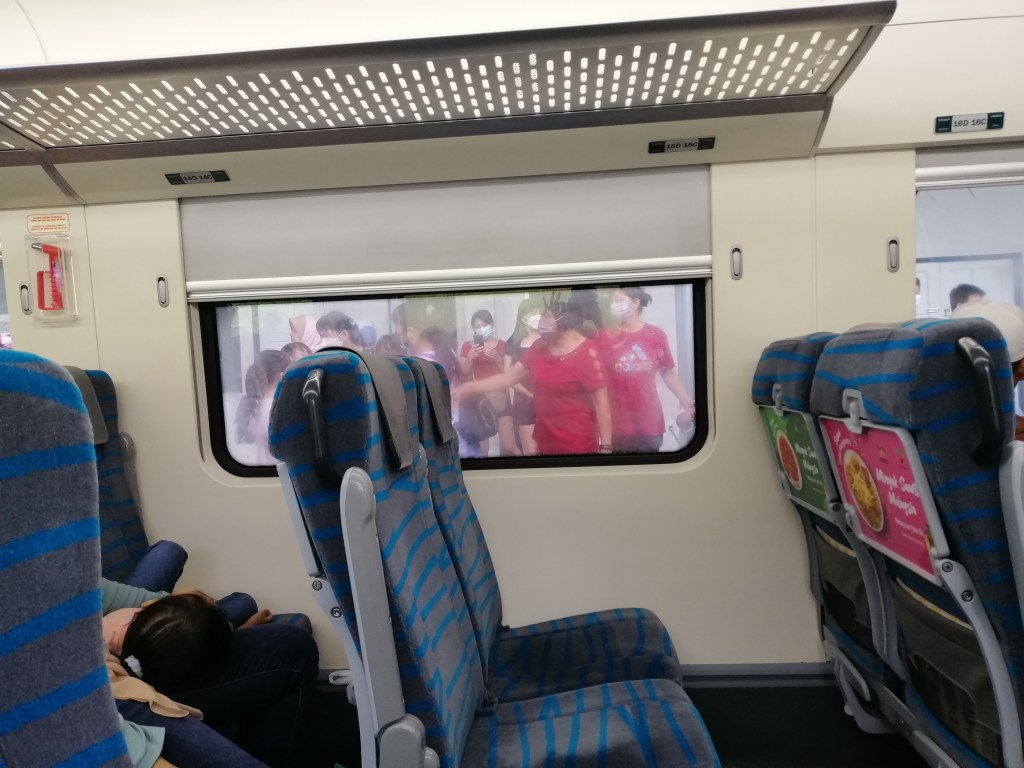
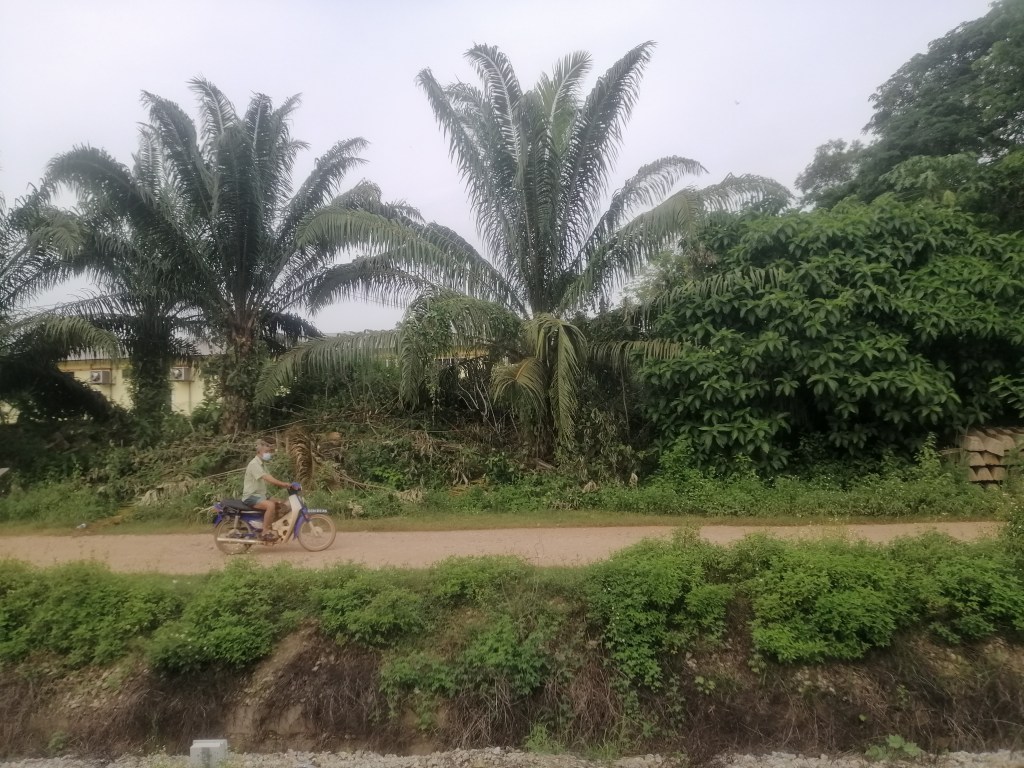


The station master had a train token around his hand. The train token (railway signalling) is a ‘key’ to allow the train engineer to pass from one section to another. At the end of each section, the engineer must surrender the token to the station master and collect the next token for an onward journey. This is particularly used in single track lines to ensure safety. No trains are allowed to pass without these tokens. They are exchanged at strategic stations along the route.
Kuala Krau Station is picturesque as the sun dipped below the surrounding distant mountains. However, beware, mind your step means just that, as the platform is much lower. The journey get interesting as we passed Sg Krau and views of muddy Pahang River. As we passed through a large scale FELDA palm plantation, the train made a brief stop. Jenderak Station is nothing more than a shed. Trucks and motorbikes rushed towards the train to collect the passengers as well a groups sending off families and friends. This train is literally the only public transport for many on this line. There are no buses or taxis at these remote stops. Dusk rolled in q.
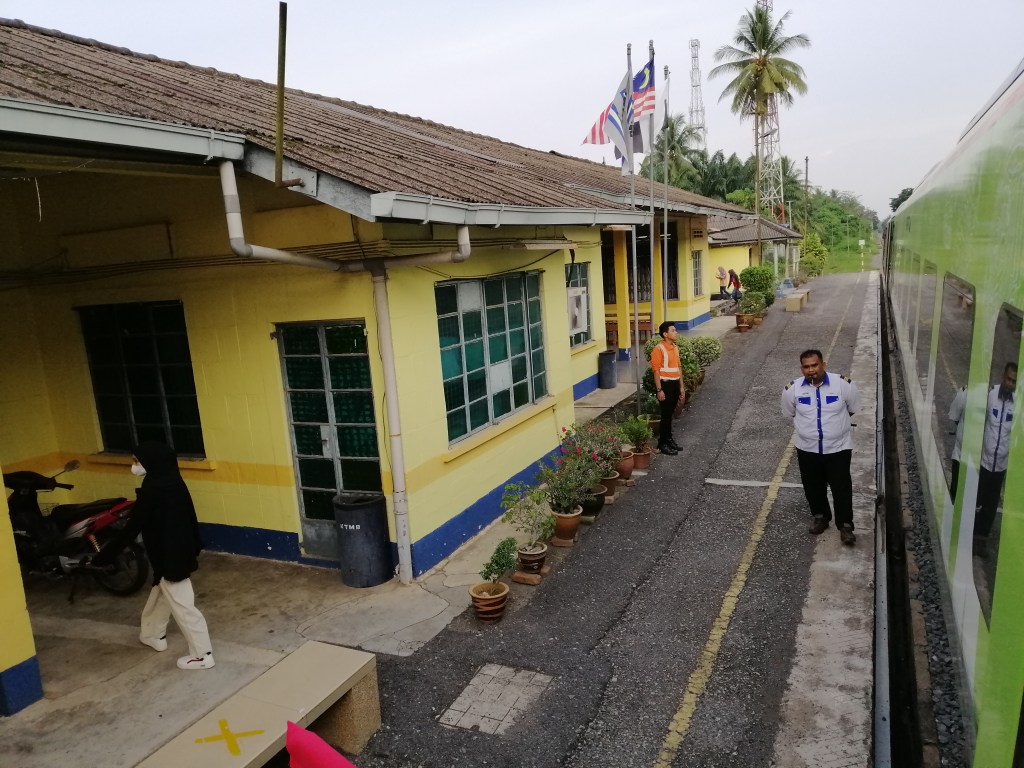

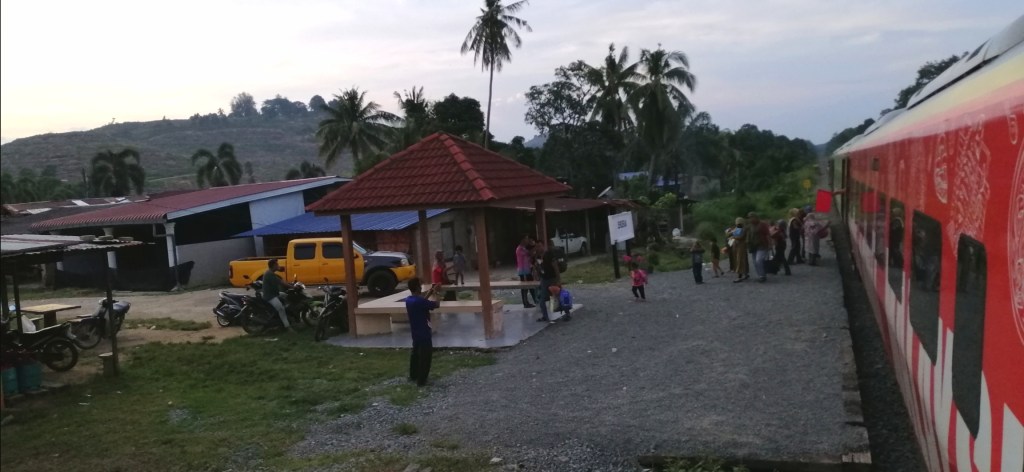
The journey crossed several tributaries of Pahang River and hills. We finally rolled into Jerantut Station at 1910. It was quiet and only a handful of passengers disembarked. I noticed that the station master had a token in his hand, destined for a train heading up to Wakaf Bahru . My SH36 DMU train however continued to Kuala Lipis and return to Gemas. From the station, it is a short walk to my accommodation in town, Jerantut Hill Hotel. Due to covid, many businesses were shut including eateries. Tomorrow, I’ll leave for Kuala Tahan to explore Taman Negara (National Park).
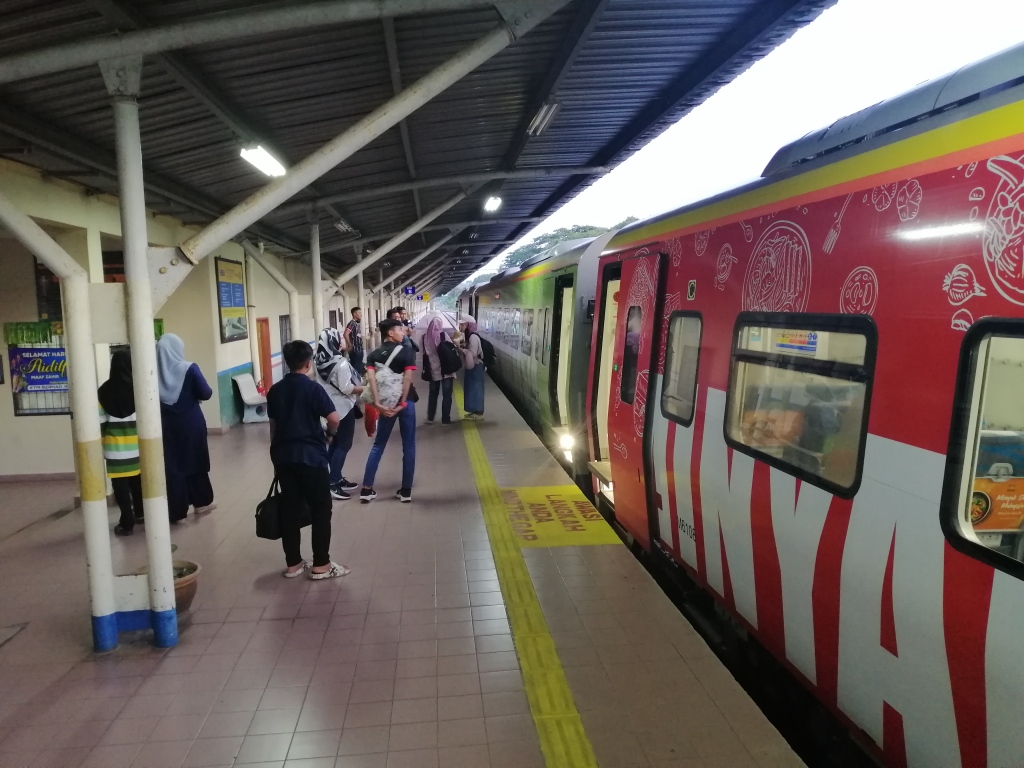
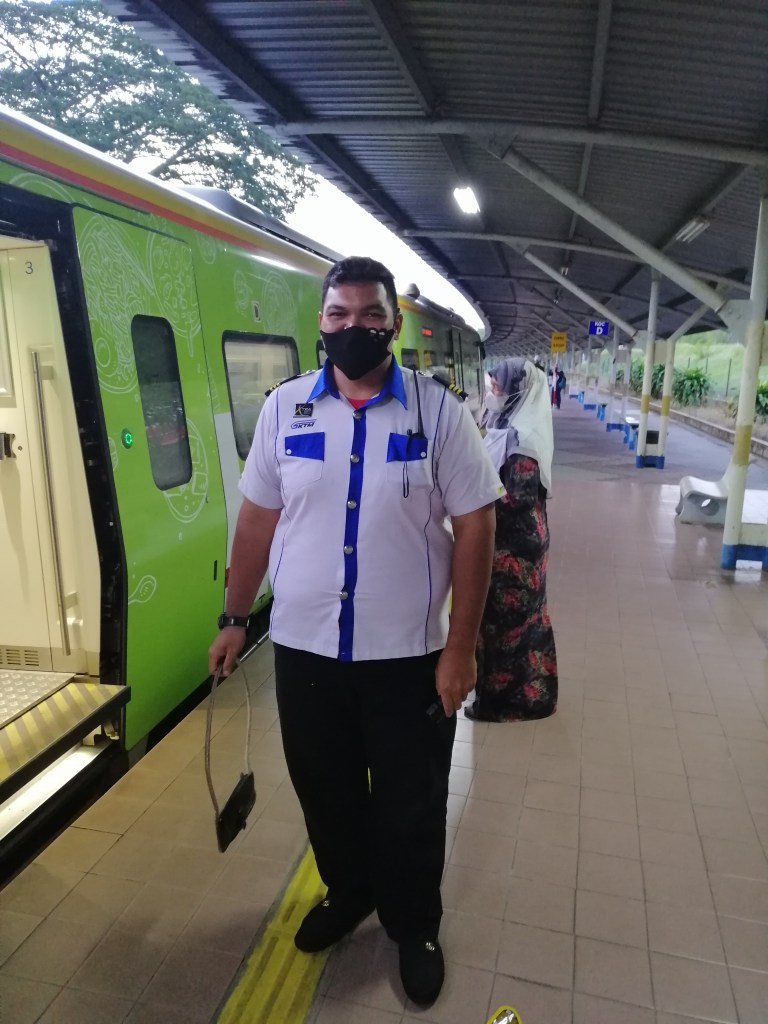
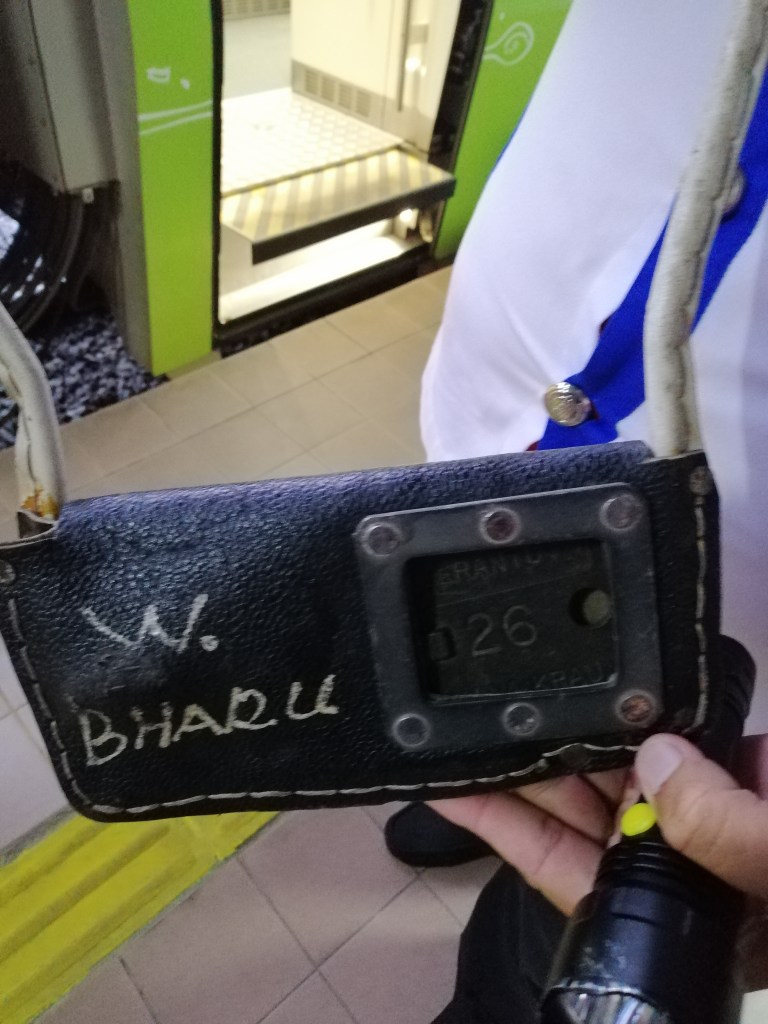
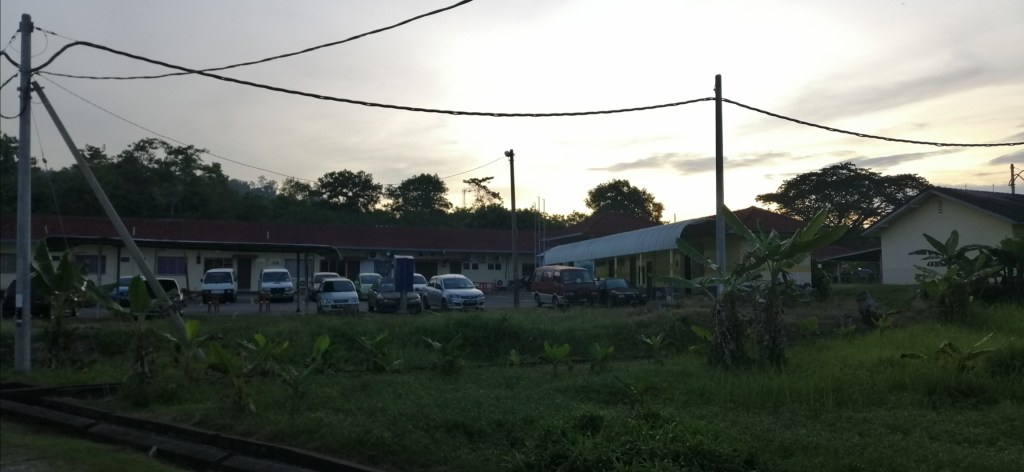
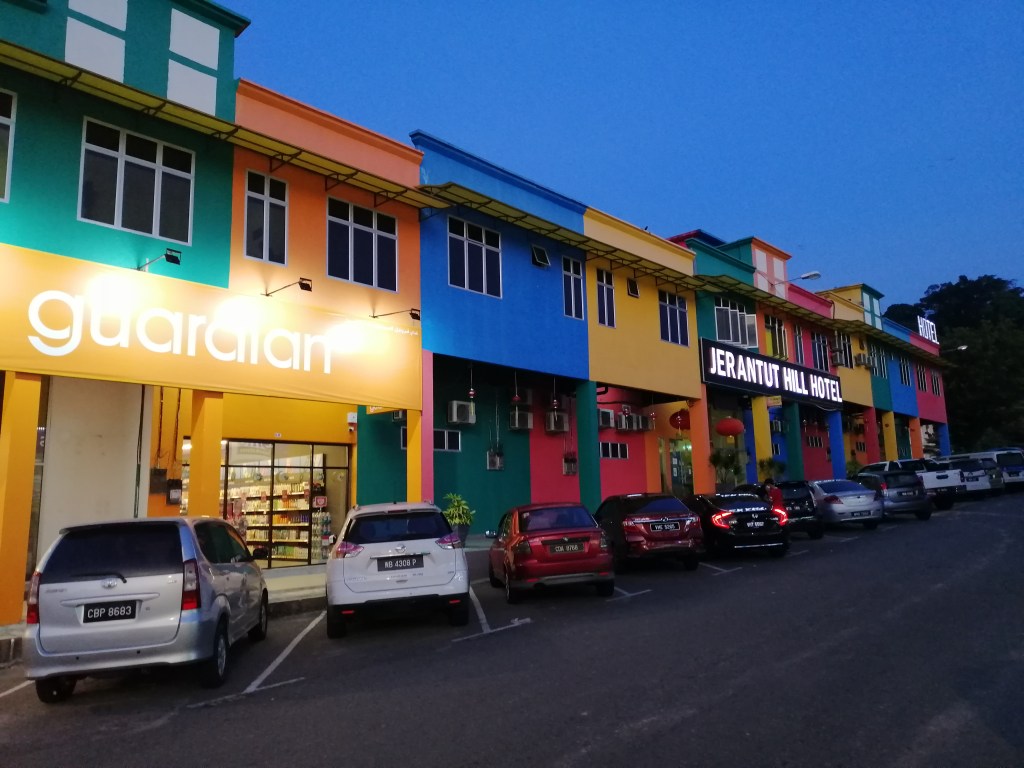
2nd leg – Kuala Lipis – Gua Musang
On my 2nd leg, my plan after visiting Taman Negara was to find transport from Kuala Tahan to Jerantut and bus to Kuala Lipis to catch the 1645 DMU Shuttle (SH60) to Gua Musang(1818). However, I managed to hitch hike from Taman Negara to initially Kuala Lipis. The foreigners were heading to Cameron Highlands. After confirmation from the polis, the road through Sg Koyan was closed. Recent heavy rains had damaged the road causing landslides and flooding. Therefore, without any option, we continued all the way to Gua Musang by road. This option meant I had more time to explore in Gua Musang. Unfortunately, there is no train journey account. The train route from Kuala Lipis to Gua Musang followed the main roads mostly through oil palm plantations. Occasionally, patches of forest appeared. Both the road and the ECRL skirt the Western boundaries of Taman Negara. A new dual carriage highway was under construction in Pahang. Strangely, it abruptly ended at the Kelantan border. Perhaps local politics at work. (Kelantan is ruled by a government opposition party). The drive was uninteresting – just hectares and hectares of oil palm plantations on relatively flat terrain. I arrived at Gua Musang around 3pm.
Kual Lipis itself, the former capital of Pahang has some interesting sights. It is located at the confluence of Jelai and Lipis Rivers which eventually drains into the mighty Pahang River. It old train station, proximity to Kenong Rimba Park and old town vibe deserves a day or two.
Gua Musang is an interesting place, in the middle of no where. In my youth, this was the place to go. So remote in the middle of the dense jungles. Back then, only logging tracks from Lojing Highlands (and Cameron Highlands) head towards Gua Musang. The ECRL was the only link to the outside world. Today, there is road access to both Lojing ang Cameron Highlands. Read here about my stay in Gua Musang.
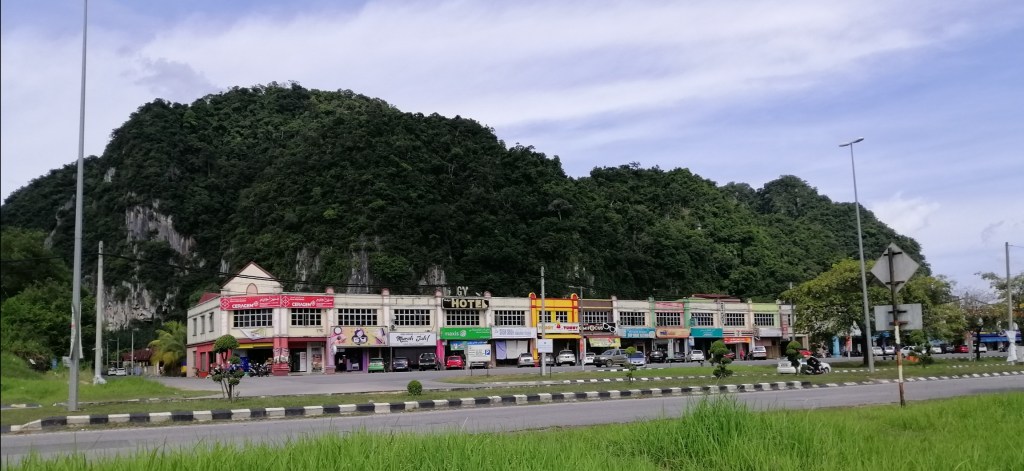
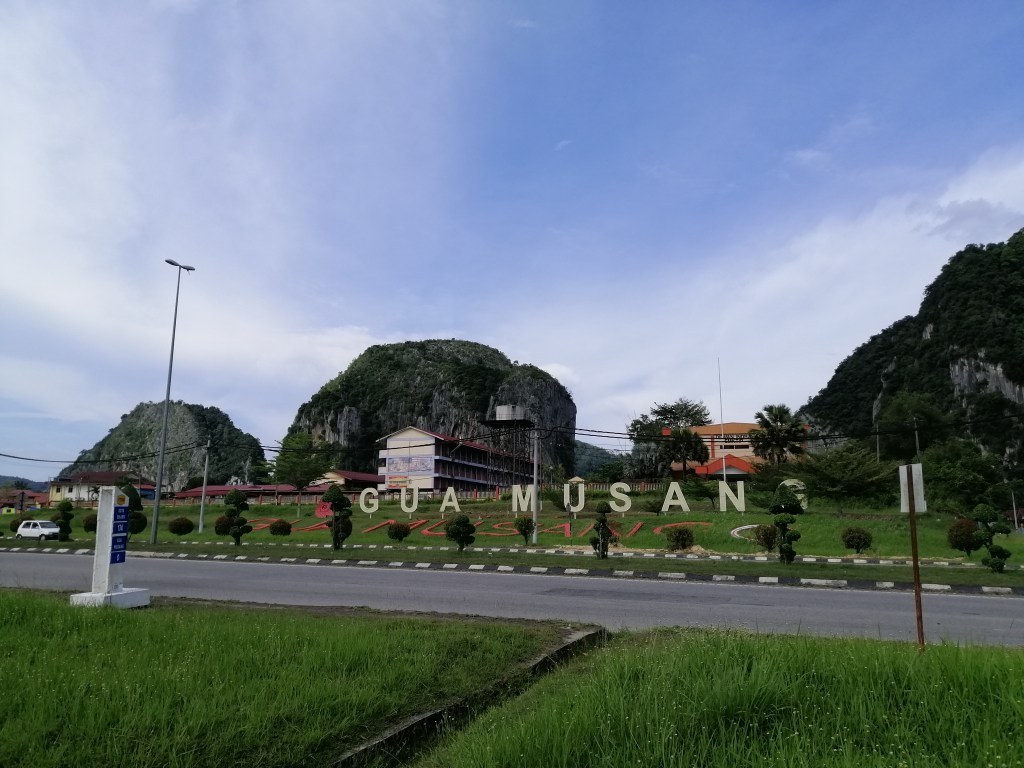


3rd leg – Gua Musang to Tumpat
This early morning I was quite excited as I headed towards the new Gua Musang train station for my 3rd leg. Thick mist descended over the many limestone hill that surround this lovely town. The street lights were on at 7am. Just before the station, a mak cik was setting up the warong (roadside stall). After a tasty homemade nasi lemak and hot condensed milk coffee, I made my way to the station. My Jungle Train – Express 26 (northbound) that departed Kempas Baru, Johor last night (2044) is expected to arrive here at 0740. Bukit Gua Musang formed a dramatic backdrop for the station. Breakfast was available at the station too. I packed some snacks for the journey. A red locomotive approached the station right on cue. Finally, the reality of taking the conventional train on the ECRL from Gua Musang to its terminus at Tumpat became a reality.
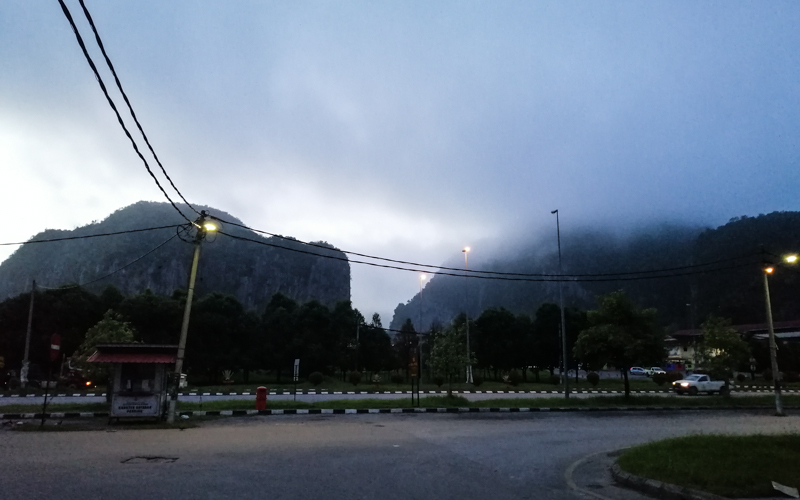

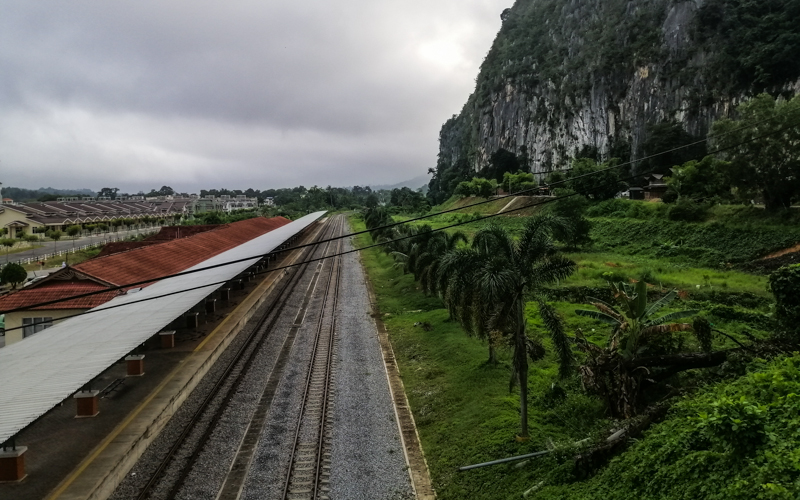
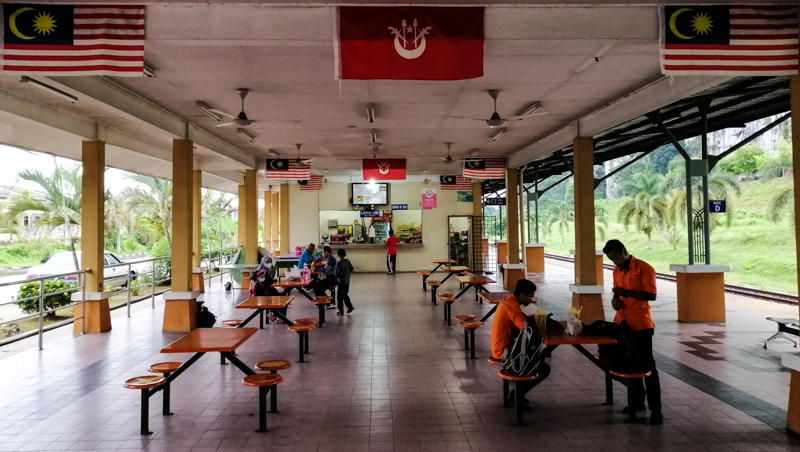
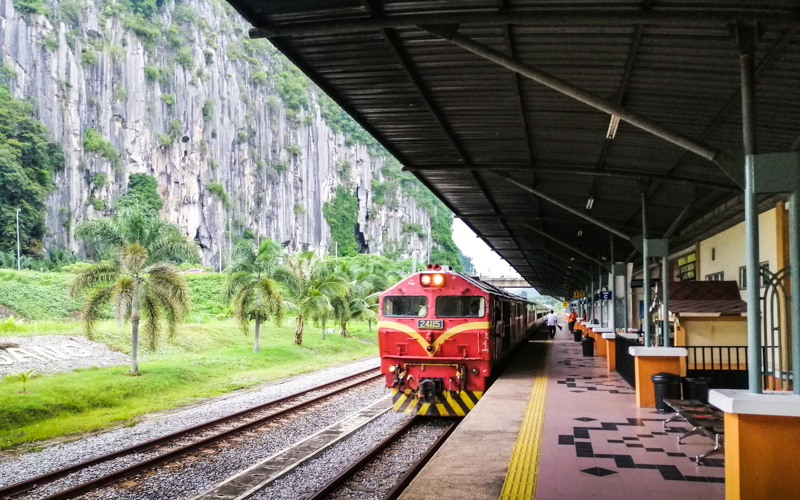
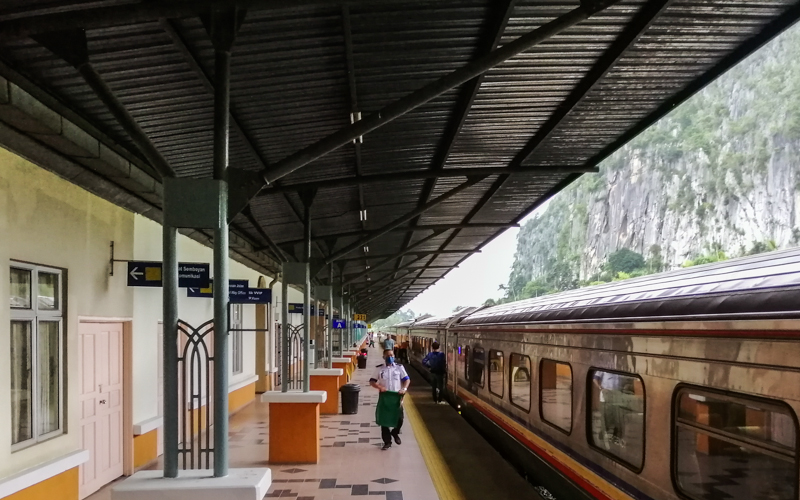

Types of seats and coaches
On this ERT26, T6 – 8 are sleeper carriages, ADNS (Air-conditioned Day/Night Second – bunk style (upper and lower berths). Each coach has 60 berths. This sleeping berths are popular and therefore, early booking is essential. There is also a buffet coach on board. The rest of the coaches T2 – 3 are sitting class – ASC (Air-Conditioned Second Class) with a 2×2 and T1 is AFC (Air-conditioned First/Business Class) with a 2×1 configurations.

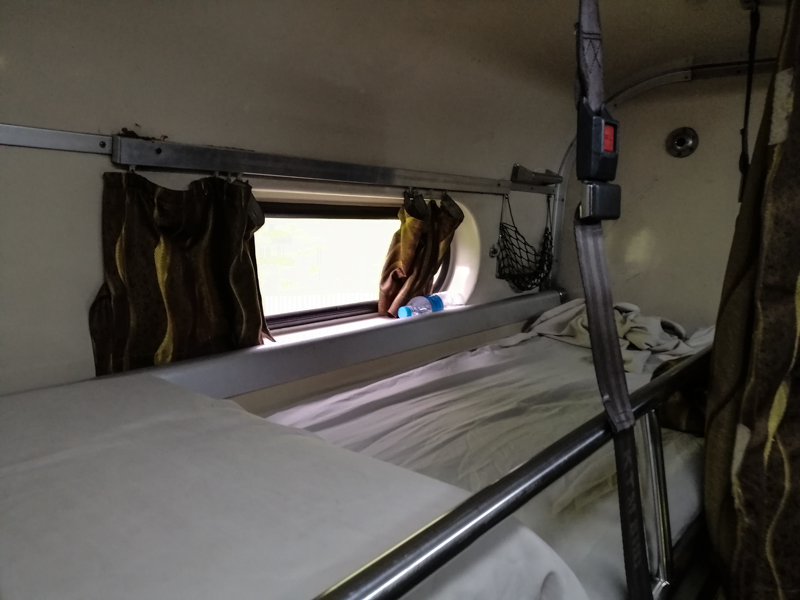
My booking was ASC with only a handful of passengers. With flag signals from the Station Master, we rolled on. The beautiful sound of the wheels rolling over the iron track and gentle sway of the carriages brought me back to childhood holidays. Only ‘negative’ were the sealed glass windows. The train whizzed pass the old picturesque wooden Gua Musang Station and the surrounding limestone hills. An Indian lady from Johor Bahru made this journey to Kuala Krai for a wedding. I ventured into the last coach T1, the AFC. It was tidy. I asked the conductor there if I could be here. ‘Help yourself, its almost empty! The end of that coach has a glass window to the outside world.

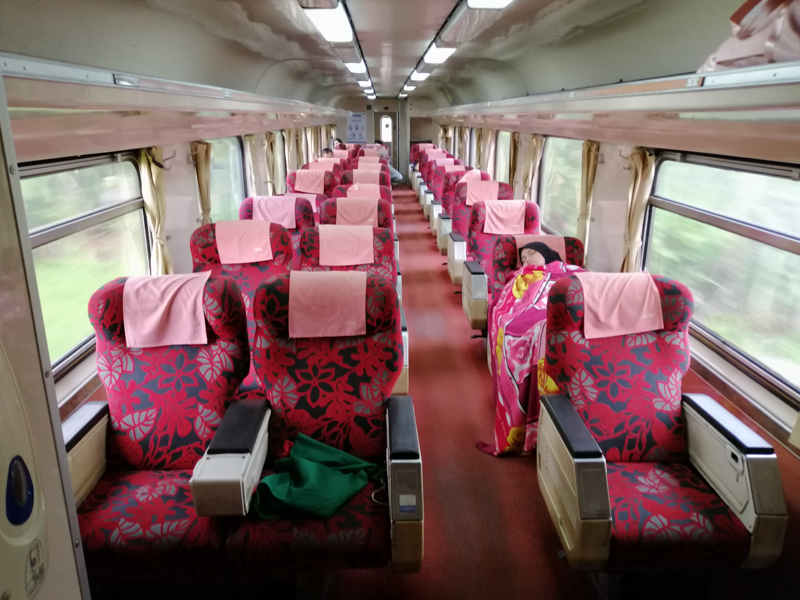

Almost immediately, we passed forests, mixed-cropping and rural scenery. The train crossed a few iron bridges and sometimes almost brushed past tall grasses. Between coaches, the doors are not automatically locked. I described about my childhood experiences with open doors and windows to the conductor. To my surprise, he opened the door. The smells of the pristine jungle and the dense and cool morning mist was heavenly. I held the door handle tightly in one hand. The cool wind brushed against my face. The track came close and followed Galas River for several kilometers until Limau Kasturi Station. It then turns and travelled west. Soon, we passed Bertam Baru Station and crossed Clementi Bridge over a muddy Betis River, a tributary of Galas River. Between dense jungles, locals cultivated cash crops like bananas and vegetables along the tracks.




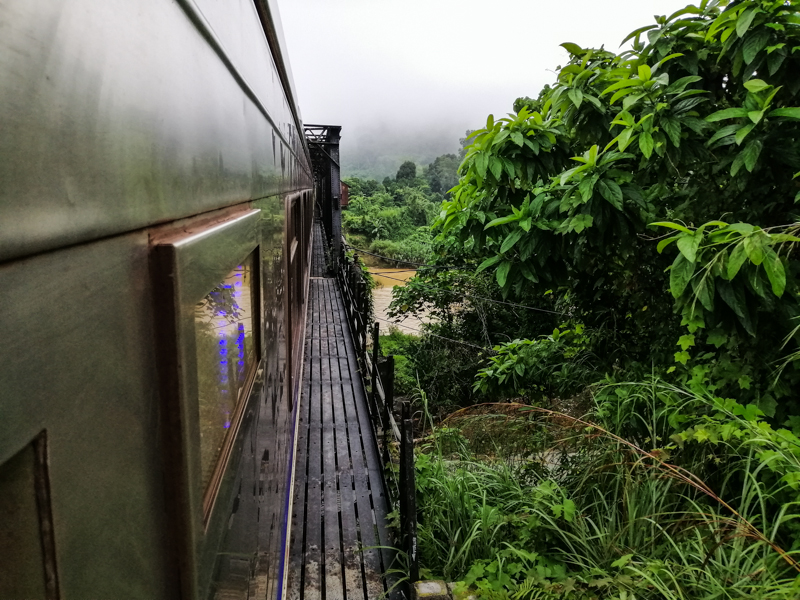
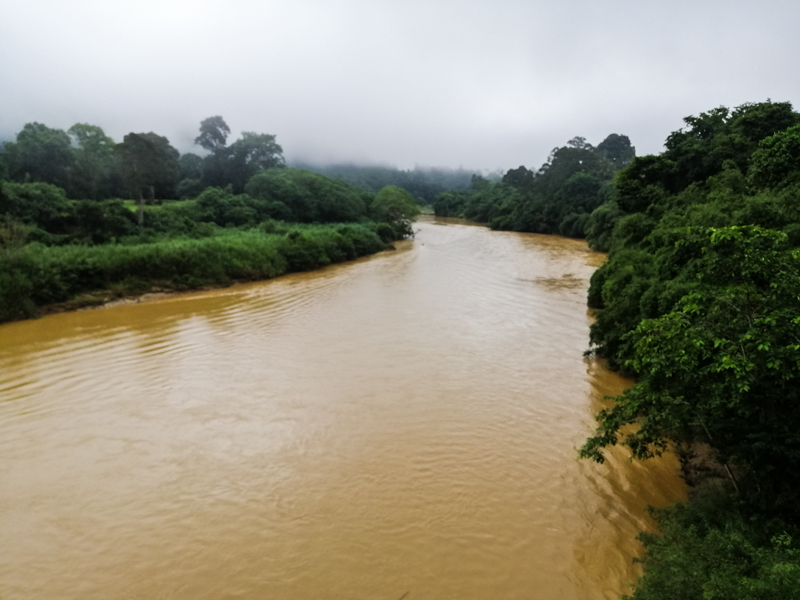
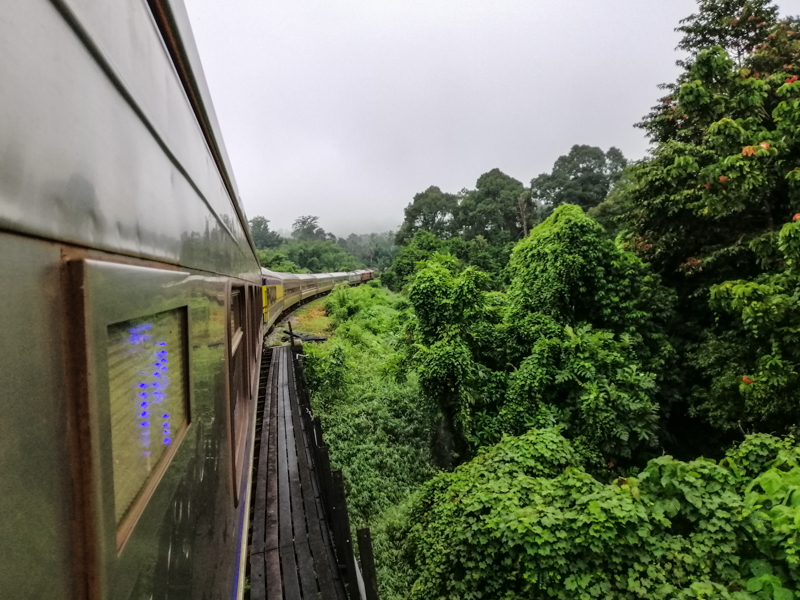
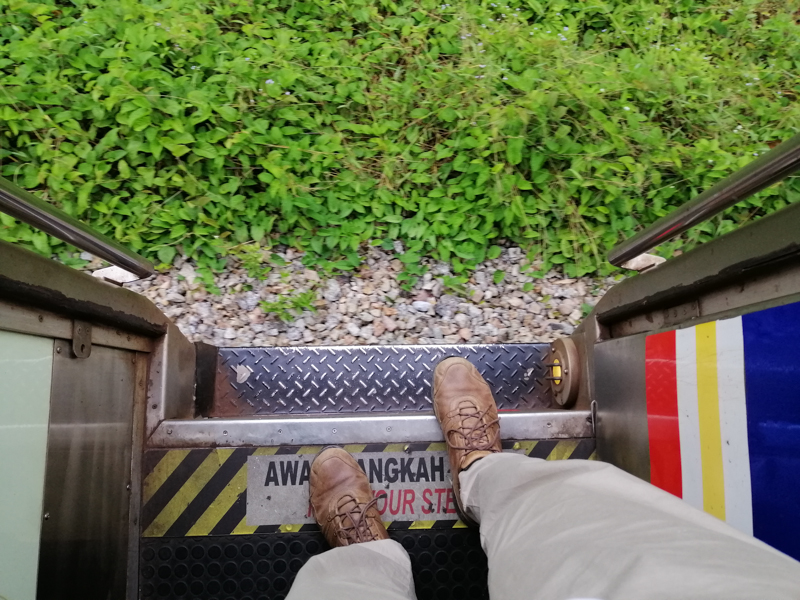
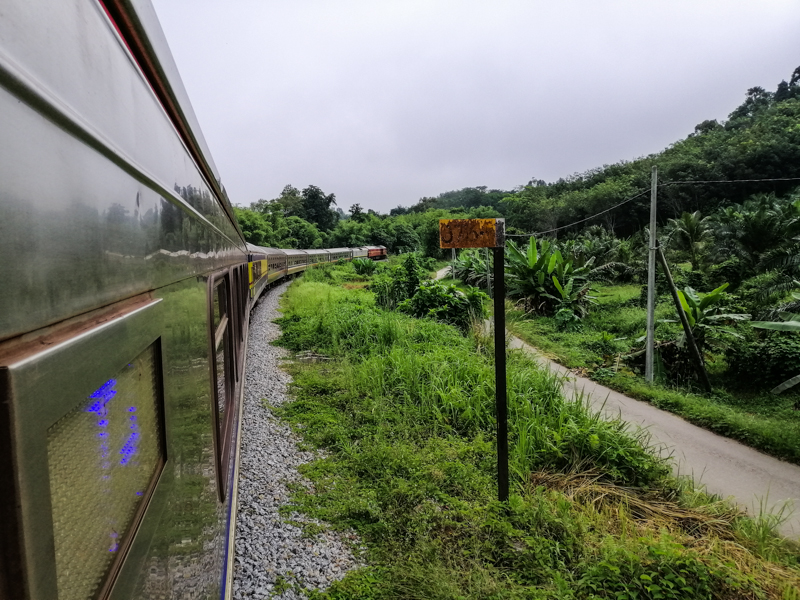
Just past 0900, we crossed Kemubu Bridge over tea coloured Galas River with a backdrop of majestic limestone hills. Pedestrians and bikes use the attached lane to cross. We soon zoomed past Kemubu Station. At 0935, we reached Dabong Station. Many people, mostly with backpacks, disembarked here. Dabong is a learning center where the ‘school train‘ brings students. Otherwise, a longer journey by road. Besides that, it is popular with hiking and cave exploration. Particularly, climbing Gunung Stong. With limited time, my journey continued north.
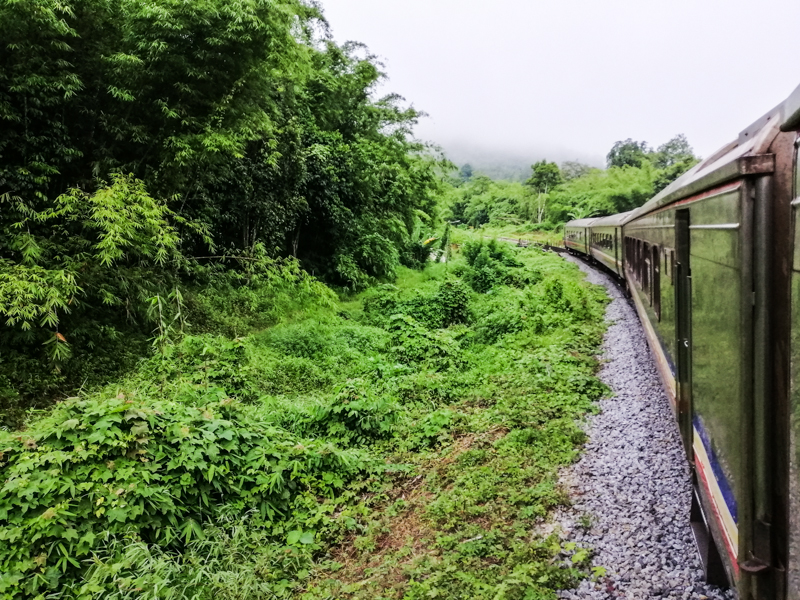
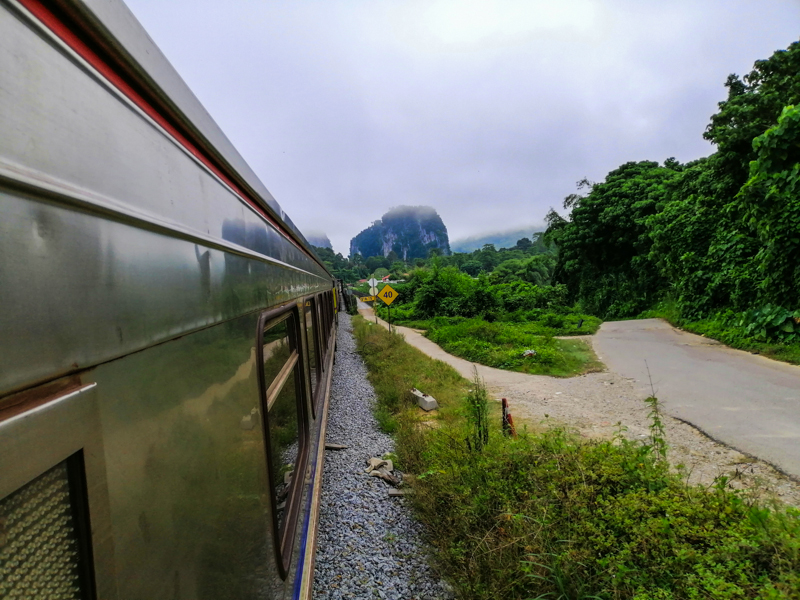

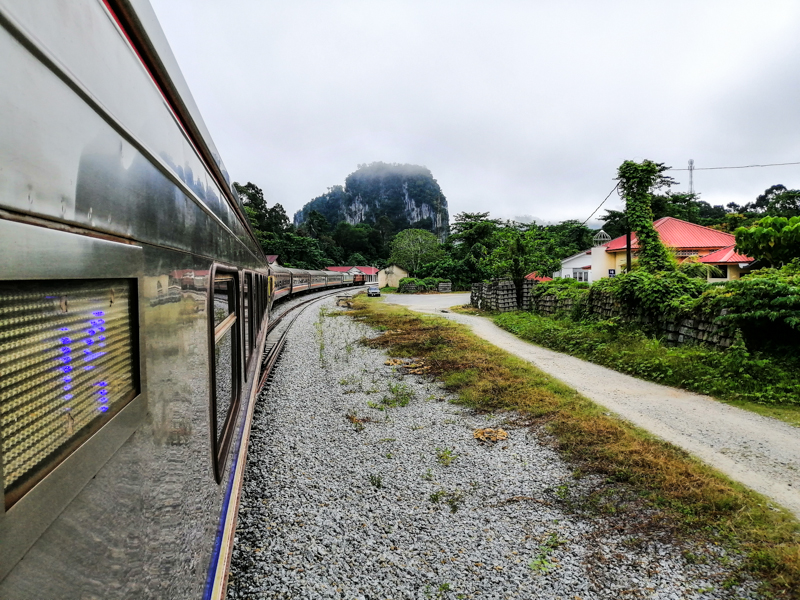
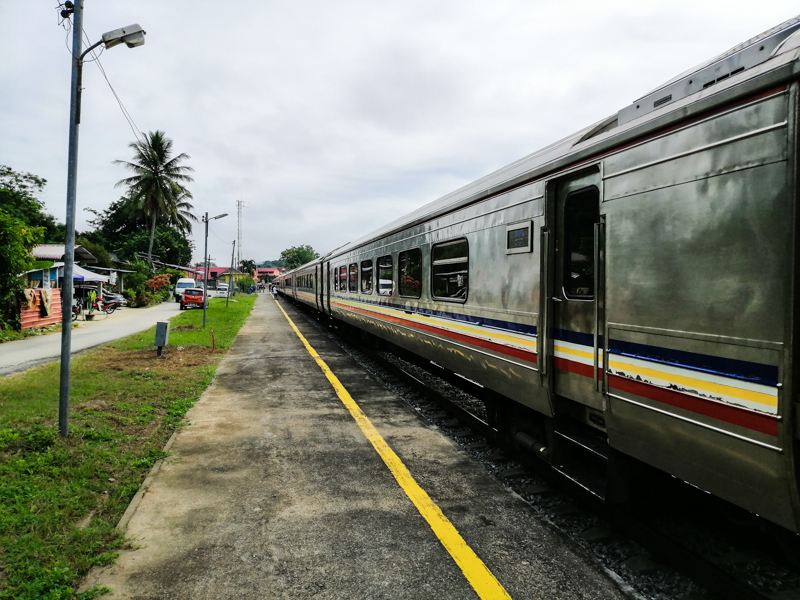
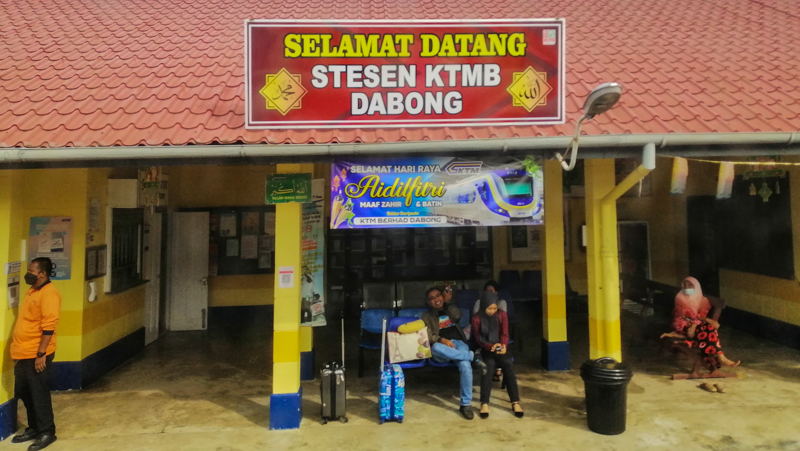
Now, following Galas River again, the track continued towards Kuala Gris Station. From here-on, the track through dense jungles veered away from Sg Galas and turned south. To facilitate the journey, engineers constructed eight tunnels and viaducts. These construction were made by the British when they occupied Malaya. These were exciting times especially on a cloudy and misty day like today. The air is crisp. Almost taste the freshness of the jungle air as the train swayed slowly from one tunnel to another inter-spread with historic viaducts that seem to float in the air. Sometimes with rivers below. As the ECRL is a single track, our EP26 stopped at Bukit Abu Station to allow the DMU train to pass. It is always interesting to witness other trains pass.

The track soon made a big U, over a mountainous and densely forested section, on a south-east direction and moved north towards Manek Urai Station. The jungle became distant as palm cultivation became prominent. The course now followed Lebir River until Kuala Krai Station. Kuala Krai lies on the confluence of Galas and Lebir Rivers. From here-on, the combined rivers becomes the mighty Kelantan River which drained into South China Sea at Kota Baru. This stretch gave the Jungle Train it’s namesake.
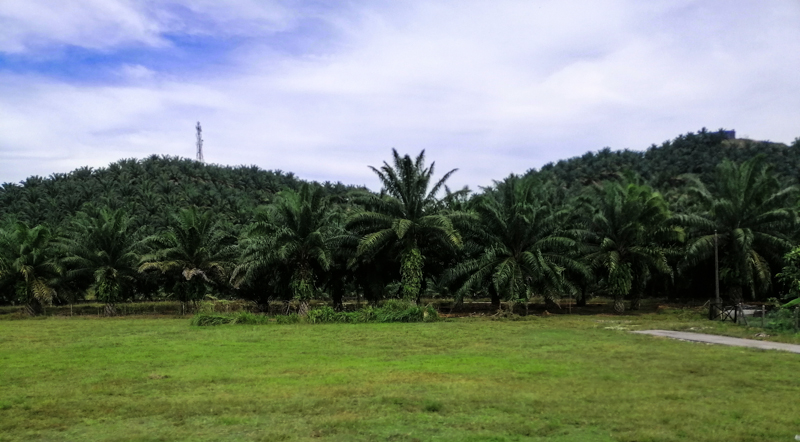
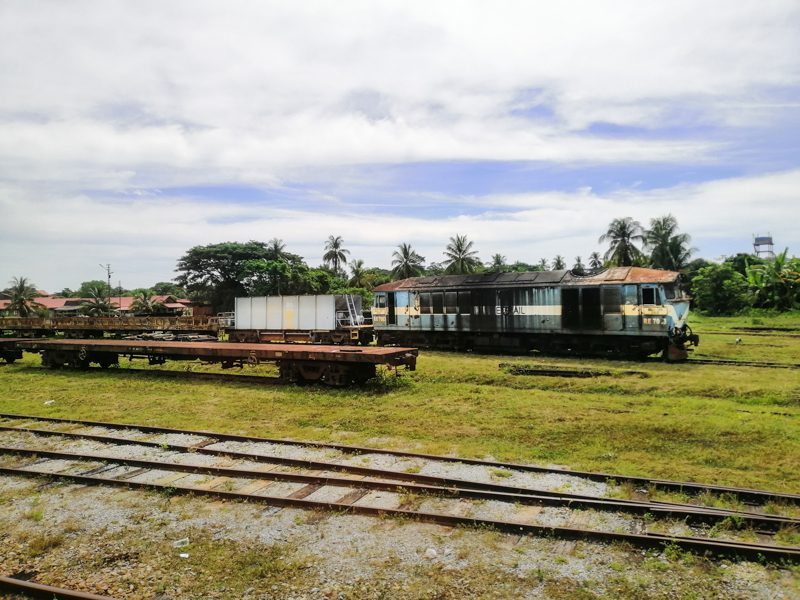
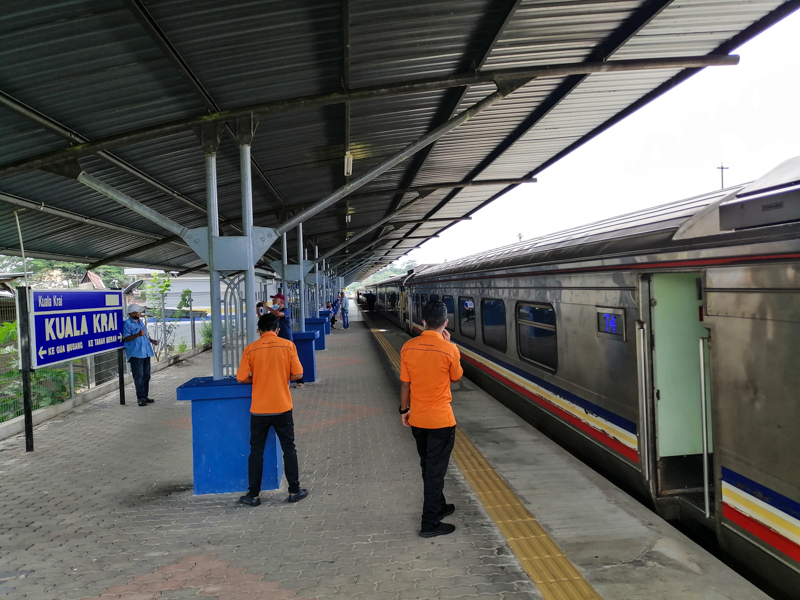
Kuala Krai Station is substantial. Perhaps an exchange station as it had several tracks. An abandoned burnt mail train engine was parked with several wagons. Near Kusial, we crossed one of the historic bridges – Guillemard Bridge over Kelantan River. The sound, jungle scenery and the river brought back wonderful memories of my childhood train experiences. It was nostalgic. This 600m single track railway truss bridge is one of the of the oldest in Malaysia. It’s historic as it was built by the British. Astonishingly, after nearly a hundred years (completed in 1924), its still not only standing but functional. A technological marvel to appreciate.
Soon after we rolled into Tanah Merah Station. Many Malay families disembarked here. returning home after the raya celebration. This is also the access to Kuala Terengganu including Perhentian Islands. The scenery became more urban as the jungle retreated into the background. We passed a couple of road crossing before reaching Pasir Mas Station. From here, there is access to Sg Golok Station via Rantau Panjang and onward into Thailand by train. From here-on, it was flat terrain with various agriculture cultivation including paddy. At Wakaf Baru Station, probably the last station, almost all passengers disembarked. Local transport was available as this station is the access to Kota Baru. However, I decided to travel further to the end terminal.



The scenery was just hectares of paddy cultivation and small villages. Buffalos grazed lazily in the hot afternoon. The train journey slowed as it approached another road crossing before rolling into the terminus station – Tumpat Station, at 1257. We were just 3 minutes slower than the scheduled time. Fantastic for a schedule that started the day before at 2044 in Kempas Baru. A journey of about 16 hours. A handful of passenger and mostly the crew assembled on the platform. Construction work on the station was still ongoing. Activities were frantic – the sleeper bed linen were removed and heaped into bundles; the cafeteria was emptied and restocked and the engineers and conductors long day was done. A distant marker indicated 527.75km. The was nothing dramatic about this place. Only at Tumpat does the ECRL actually meets the coast. Within 10 minutes, the work horse engine was detached and moved towards the terminus – the end of the line. A worker manually diverted the track to allow the engine into the adjacent track. At 1310, the engine is hooked up to the carriages at the tail end and dragged away. Next departure on the ERT27 to Kempas Baru (Southbound) is at 2030 tonight.
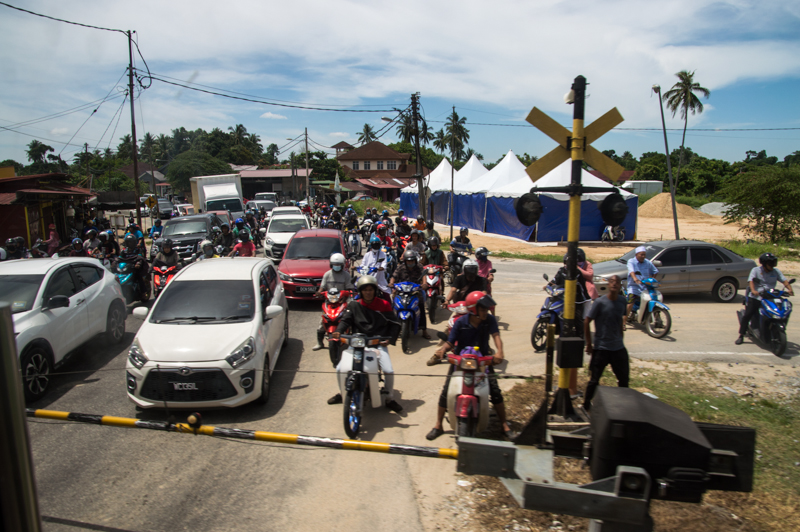


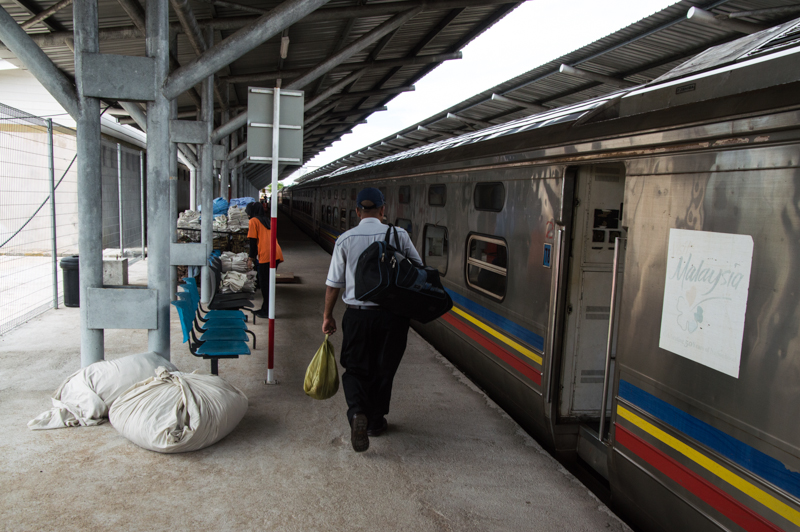
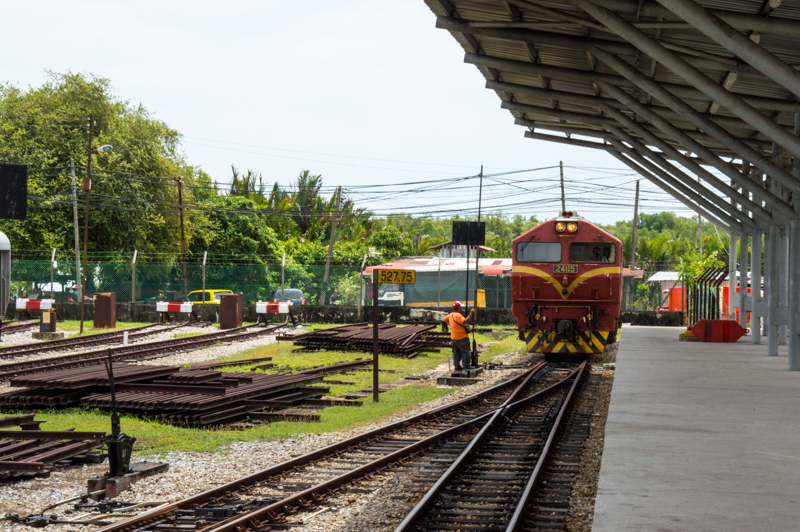
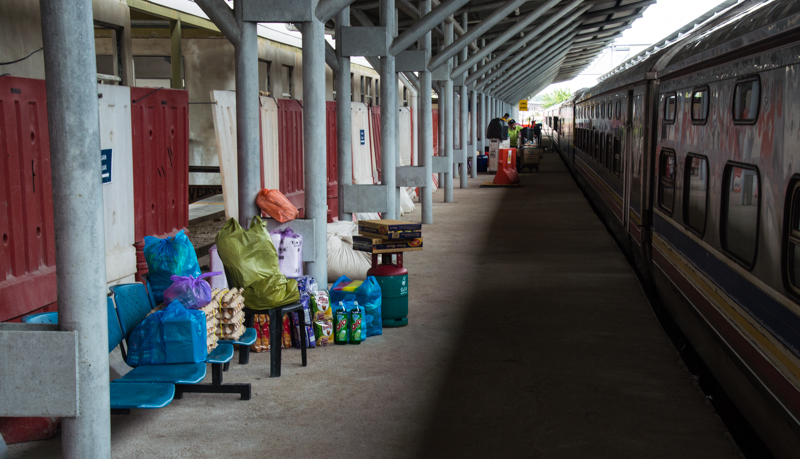

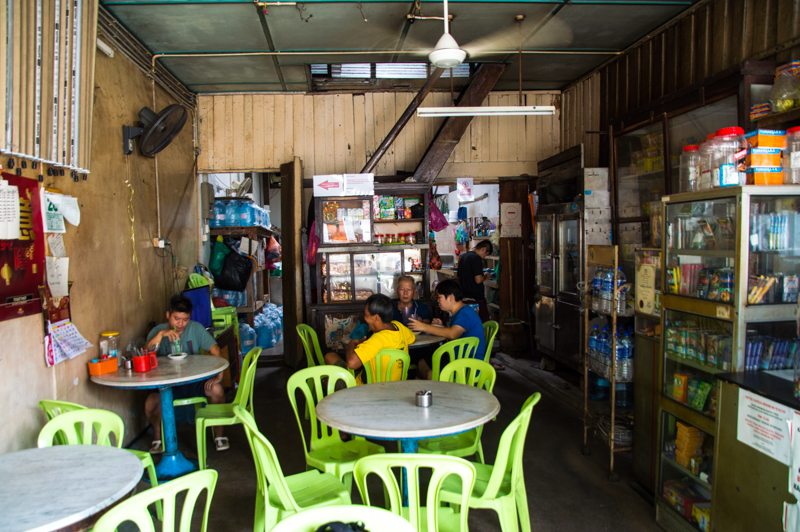

Summary and tips
The East Coast Railway Line lived up to its name as the ‘Jungle Train’. An opportunity to encounter rural life. The other sections encountered rural life and passively traveled through interior towns normally not witnessed if travelled by road.
(1) The section between Gua Musang and Kuala Krai is the best ‘jungle’ experience – jungles, historic floating bridges (viaducts), village scenery, haunting tunnels, spectacular limestone hills and networks of ‘teh-tarik’ colored rivers. (2)To experience the jungle ride, the ERT26 (eastbound) offered daytime experience. (3) I suggest doing the journey in several legs including stops in Gemas (old town) , Jerantut (to Taman Negara), Kuala Lipis (historic/old town), Gua Musang (cave exploration/old town railway station) and Dabong (mountain/cave exploration). This offered off the main highway, truly Malaysian town/village experiences. It is certainly a fascinating journey worth doing.
I am not sure whether plans to electrify the ECRL or the disappearance of the jungle will come first. To experience the jungle is to be exposed to the exterior by way of open windows and doors. However, with modernisation, coaches are air conditioned. Therefore, sealed windows. Almost sanitised from the exterior environment. Another important aspect of conventional train travel, in a single line like the ECRL, is the use and exchange of tokens. This art will be extinct with introduction of electronic communication. The future for this train is incorporate a ‘tourist train’ with open windows coaches. This will preserve this iconic experience. Perhaps, this might help stop the ‘disappearance’ of the jungle itself. The novel idea of KTM to provide ‘student transport’ in rural areas to pursue education would certainly affect negatively to many rural families. As always, the best time to travel and experience this Jungle Train in Malaysia, is now.
East Coast Rail Link (not to confused with the existing ECRL – Jungle Train) is mega project to join rail from the west coast – Port Klang through KL and onward to Mentakab to Kuantan and along the coast up to Kuala Terengganu and Kota Baru. It cost about RM50 billion and 30% completed with the help of Chinese State owned companies. Will this bring about the demise of the Jungle Train?
Route and schedule
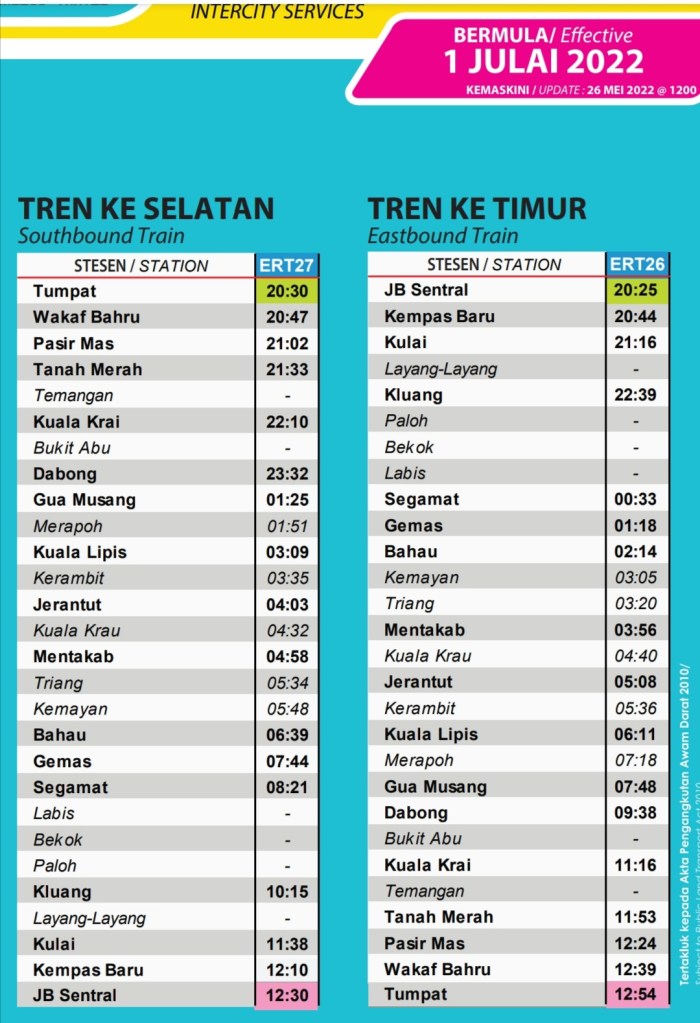
Riding the trains in Malaysia
Read all about bookings, trains and interesting destinations while Riding the Trains in Malaysia.
